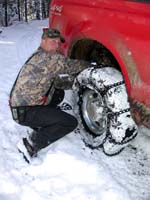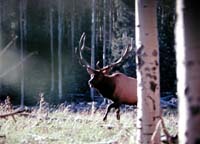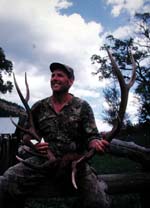
|
Features
|
|
|
|
Books
|
|
|
|
Fun & Games
|
|
|
|
Contact Us
|
|
|
John's Journal... Entry 175, Day 2
STEVE PUPPE ON ELK HUNTING IN THE BITTERROOT MOUNTAINS
Road Hunting Elk
 EDITOR'S
NOTE: Steve Puppe of Hamilton, Montana, promotions
director for Knight Rifles and longtime avid hunter, lives on the edge
of the Bitterroot National Forest with its abundant elk, mule deer and
white-tailed deer.
EDITOR'S
NOTE: Steve Puppe of Hamilton, Montana, promotions
director for Knight Rifles and longtime avid hunter, lives on the edge
of the Bitterroot National Forest with its abundant elk, mule deer and
white-tailed deer.
QUESTION: What does road-hunting elk mean?
ANSWER: Road-hunting sounds like a bad deal, but you're actually covering
a lot of ground. Elk are social animals and spend a lot of time in herds.
You can walk and walk and not find any elk. So I'll get on some of these
roads where I can glass long distances and locate elk that way. Then I'll
put a game plan together on how I'm going to get to them. I'll just take
back roads up in the forest. I'll get up on a high point and glass some
big draws. Road-hunting an elk may be as simple as driving around and
accessing where he is from a different point. I save miles on my feet
by driving around. Sometimes I may be down on the bottoms, and I'll take
a spotting scope to spot the elk from a long distance. With your naked
eye, you won't even see the elk. But when you pull out a 20X or 30X spotting
scope, you may see elk out in the middle of a big meadow. The hunter who
doesn't take the time to spot may never know the elk are there. I do a
lot of spotting from the roads and then put a plan together of how to
access them. Elk move around a lot so they may be at one site today and
four miles away tomorrow. This is why I drive down the roads and cover
as much territory as I can, figuring out where they are for the day and
then spending the rest of the day hunting them.
 QUESTION:
The day we hunted together a fog set in, snow started coming down, and
we didn't have more than 30 or 40 yards of visibility. Why would you road-hunt
in this kind of weather?
QUESTION:
The day we hunted together a fog set in, snow started coming down, and
we didn't have more than 30 or 40 yards of visibility. Why would you road-hunt
in this kind of weather?
ANSWER: These are the toughest conditions to have. Again, I cover some
miles and hope with fresh snow that I can get onto some elk tracks. Often,
if you get into a group of tracks, seven or eight sets of tracks, they
are from cows and calves. But if you can find a single track or maybe
two tracks, then there's a good chance it is a bull. With these conditions,
elk can't see as well either.
 Snow
and fog conditions present a good opportunity to get on a track. Just
go slow, and see what the animal does -- maybe learn where he crosses
a road. If he's feeding, he's obviously going slowly, and you'll have
a good chance of walking up on him feeding or laying in the bed somewhere.
Go as slow as possible, and watch to see what's in your surrounding area.
Depending on the tracks and the terrain, I may or may not get out and
go after him. If you see a track going across the road at a full-tilt
run, you'll likely never catch up with that animal. If he's just walking
and meandering, you have a good chance at finding that elk.
Snow
and fog conditions present a good opportunity to get on a track. Just
go slow, and see what the animal does -- maybe learn where he crosses
a road. If he's feeding, he's obviously going slowly, and you'll have
a good chance of walking up on him feeding or laying in the bed somewhere.
Go as slow as possible, and watch to see what's in your surrounding area.
Depending on the tracks and the terrain, I may or may not get out and
go after him. If you see a track going across the road at a full-tilt
run, you'll likely never catch up with that animal. If he's just walking
and meandering, you have a good chance at finding that elk.
To learn more about Knight Rifles, call (641) 856-2626, write them at Knight Rifles, Customer Service Dept., 21852 Hwy J46, Centerville, IA 52544, or visit the Web site www.knightrifles.com. You can contact Scott Boulanger, a dependable, expert elk guide in this section of Montana by writing him at P.O. Box 733, Darby, Montana, 59289. You can call him at (406) 821-0017, E-mail him at elkhunter@circlekbl.com, or visit his Web site www.circlekbl.com.
TOMORROW: HUNTING AFTER BUGLING SEASON
Check back each day this week for more about STEVE PUPPE ON ELK HUNTING IN THE BITTERROOT MOUNTAINS ...
Day 1 - Hunting A Fringe
Area
Day 2 - Road Hunting Elk
Day 3 - Hunting After Bugling Season
Day 4 - Why You Wait On An Elk
Day 5 - Equipping The Elk Hunter